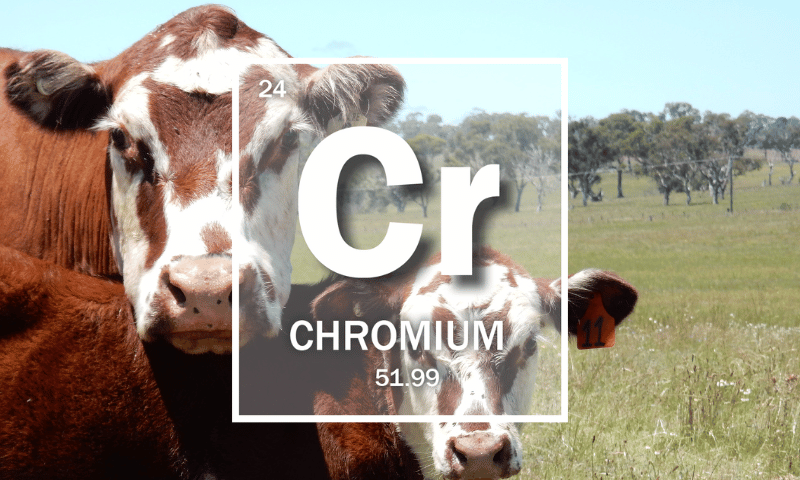Chromium (Cr) was discovered by the Frenchman Louis Nicolas Vauquelin in 1797 and was named for the Greek word chroma meaning colour. Chromium is a blue-white metal that is hard, brittle, and resistant to corrosion. Chromium can be polished to form a very shiny surface and is often plated to other metals to form a protective and attractive covering (Jefferson Lab Resources, 2021), it’s used in kitchen cutlery, appliances, cookware and automotive designers use chrome rims and wheels to spruce up their cars (Stoll, 2021). Chromium forms many colourful compounds, with rubies and emeralds owing their colours to chromium compounds.
Chromium is Essential for Animals
Chromium is an essential mineral that is present in small amounts in all animal tissues. The beneficial effects of chromium in human health include a role in the maintenance of normal blood and sugar cholesterol levels due to the mineral being involved in glucose homeostasis making supplementation, particularly for people with type 2 diabetes and insulin resistance.
The function of chromium in the animal body as reported by Ewing (2007), includes:
- Being a component of the glucose tolerance factor (GTF) that enhances the effect of insulin
- Stimulating insulin activity and glucose uptake by organs and muscle
- Aiding glucose metabolism and stimulating the synthesis of proteins
- Acting as an enzyme activator involved in the production of energy from carbohydrates fats, and protein
- Being involved in nucleic acid metabolism and therefore protein synthesis
- Potentially having some involvement in regulation of cell growth
- Stimulating fatty acid and cholesterol production in the liver
Livestock Benefits Associated with Chromium
In a review of chromium in livestock nutrition, Amata (2013) reported that studies into the benefits of chromium supplementation in livestock diets have shown:
- It improves immune function
- It plays a key role in lipid, protein, and nucleic acid metabolism in livestock
- It has a positive effect on egg production, egg quality and egg cholesterol levels in laying hens
- It positively affects milk production in cows and has a profound effect on calf growth
- It has a positive effect on growth and carcass composition in swine
- It alleviates the negative effects of stress by improving the health and performance of livestock
- Increased immune response, energy status, dry matter intake and milk yield in primiparous cows and reduced morbidity in calves, as reported by McDonald (2011).
The practical significance of chromium supplementation in the nutrition of farm animals is still being investigated and no recommendations for dietary levels have been made (McDonald, 2011), however, research has identified situations in which chromium supplementation might have a commercial application, e.g. periods of stress, both environmental and metabolic (Ewing, 2007).
What Does Chromium Deficiency Look Like in Animals?
Although specific daily requirements for chromium are still being investigated, Ewing (2007) reports chromium deficiency can have the following negative effects:
- High blood sugar and the loss of sugar in the urine due to the affected glucose metabolism, protein and lipid metabolism will also be affected
- Hyperglycaemia, due to the affected insulin output and activity
- Increased blood cholesterol levels
- Protein synthesis is indirectly affected
- Necrotic liver degeneration and increased mortality resulting from reduced growth rate
How AgSolutions Can Help
Chromium is an essential mineral for livestock productivity and health. As chromium is a trace mineral only small amounts are required, although specific requirements are yet to be determined for livestock.
To help ensure that stock are receiving chromium in their diet all of the MegaMin Livestock Supplements and MegaMin Equine Supplements contain chromium along with broad spectrum macro and trace minerals to help support overall health and production.
Ask about our products and services at your preferred store or contact our Head Office on 1800 81 57 57.
You can also contact our Field Advisors and find the closest one to you.
Bibliography
Amata, I. (2013). Chromium in Livestock Nutrition: A Review. Global Advanced Research Journal of Agricultural Science, Vol. 2(12) 289-306.
Ewing, W. C. (2007). The Minerals Directory. Leicestershire: Context.
Jefferson Lab Resources. (2021, August 30). The Element Chromium. Retrieved from JLab Science
Education: https://education.jlab.org/itselemental/ele024.html
McDonald, P. E. (2011). Animal Nutrition Seventh Edition. Essex: Pearsom Education Limited .
Stoll, C. (2021, August 30). Facts About Chromium. Retrieved from Live Science: https://www.livescience.com/29194-chromium.html
